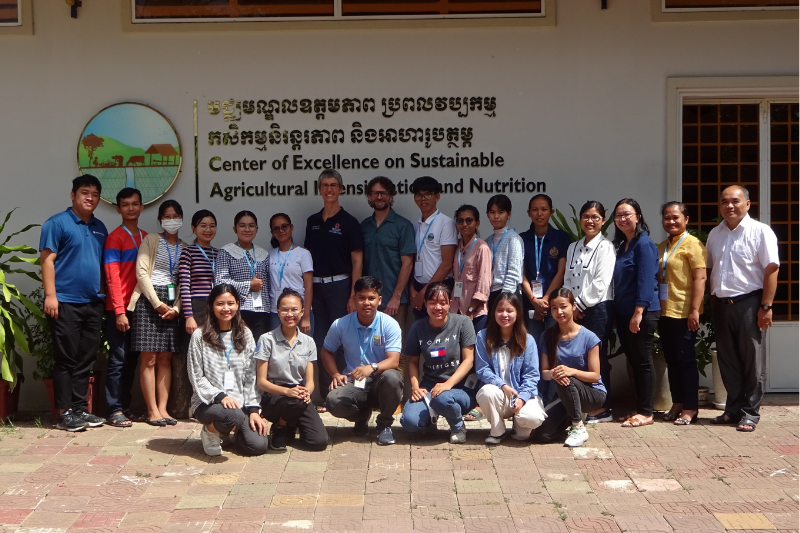
From informing an experiment’s design and analyzing data to interpreting results and informing decision-making, statistics ensure that research outcomes are both sound and publishable. Because statistics expertise is a key part of strengthening agricultural research capacity, researchers with the Feed the Future Innovation Lab for Food Safety (FSIL) recently held an intensive, week-long agricultural statistics course at Cambodia’s Center of Excellence for Sustainable Agricultural Intensification and Nutrition (CE SAIN) at the Royal University of Agriculture in Phnom Penh.
The course was taught by Dr. Nora Bello, professor of systems modeling in the Department of Animal Sciences at The Ohio State University and co-principal investigator (PI) of a FSIL-funded, Cambodian-led research project to reduce foodborne pathogens in nutritious, but highly perishable, salad vegetables in Cambodia. Through this project and others, Bello recognized that Cambodia’s surging research capacity had created a need for more advanced statistics training.
“The research engine in Cambodia has really ramped up in recent years,” said Bello. “More people and more institutions are involved, and the increasing sophistication of the research questions being addressed often calls for studies that require more complex experimental designs. The need for training in more sophisticated methods of data analyses is but a natural consequence of this growth process in research capacity.”
The course was developed by Bello with support from project co-lead PIs Dr. Paul Ebner, professor of animal sciences at Purdue University, and Dr. Jessie Vipham, associate professor of animal sciences at Kansas State University. The statistical topics covered were selected based on a precourse survey that assessed the local research needs and the background knowledge of a sample of participants. Bello developed the lectures, class discussions and hands-on practical data analysis exercises using statistical software, drawing on relevant datasets from ongoing local collaborations. She further prepared attendees to design experiments that will best address their own research questions and to select appropriate statistical methods for data analysis.
In addition, course participants had the opportunity to consult with Bello on planned and ongoing research projects. Consulting sessions helped researchers specify a statistical model that properly reflects their data generation process and was thereby tailored to their research project. Further support included troubleshooting how to fit the model to their data and how to conduct testing and articulate results. And because consulting sessions were open to all attendees, the class worked as a group to practice statistics using the wide range of research projects and data brought forward by their peers.
“This statistical modeling training program has been incredibly beneficial to me as a researcher, allowing me to enhance my skills and improve the overall quality of my research,” said Oudam Heng, lecturer and researcher at the Institute of Technology of Cambodia (ITC). “Prior to participating in this training session, I faced significant challenges when it came to selecting an effective method for analyzing and interpreting my research data in a more scientific manner. In addition to gaining a deeper understanding of statistics, this program has also provided me with valuable knowledge on designing studies with adequate power to reach conclusive results.”
In addition to ITC, the 24 attendees included students, faculty, postdoctoral fellows and research associates from CE SAIN, the Royal University of Agriculture (RUA) and the Institut Pasteur du Cambodge (IPC). Because of the participation of researchers from across the agricultural research community, the class learned from peer datasets involving topics like food safety in informal vegetable markets, antimicrobial resistance in aquaculture and microbial pathogen contamination in mixed livestock-vegetable farms. Regardless of the specific domain, the underlying theme of the course was the proper use of statistics to ensure a sound and reproducible approach to data collection and analysis. Throughout, Bello, Ebner and Vipham’s ultimate goal was to increase the credibility — and therefore the potential impact — of Cambodian-led scientific research through successful publication in indexed, peer-reviewed scientific journals.
“If you do research and no one ever reads it, it’s like it never happened,” said Ebner. “The number one reason a study is going to get rejected from a journal is if the experimental design and statistics don’t test what you think you’re testing.”
To help participants prepare for publication, Bello also shared examples of how to describe the methods and results for different statistical analyses in a journal article. This and other collaborative course activities were intended to bridge what Bello feels is an increasingly urgent global gap between domain-specific scientific research and statistical expertise — one that she notes is crucial for research to retain its credibility and impact on decision-making. Working together with colleagues, she has recently held similarly themed, locally tailored workshops in the United States, Canada, Uruguay, and Argentina.
“If you want capacity growth that really stands by itself, that’s independent of any specific person, it needs to be growth through people, through capacity development,” said Bello. “We need to be training students that can take the baton further.”
Amanda Garris is a communications specialist with FSIL. The Innovation Lab is one of a network of 20 such labs led by U.S. universities under Feed the Future, the U.S. government’s global hunger and food security initiative led by USAID.

